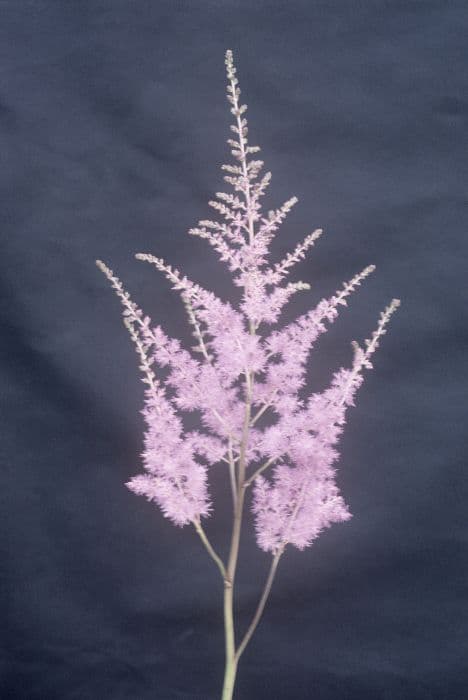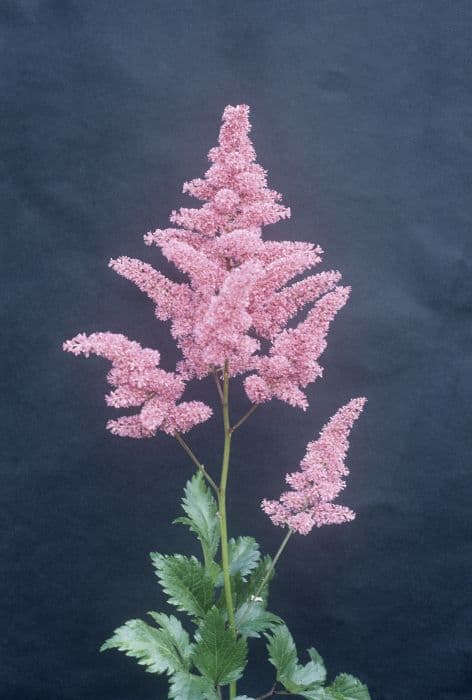False Spirea Astilbe 'Feuer' (× arendsii)

ABOUT
Astilbe 'Feuer', commonly known as False Spirea or False Goat's Beard, showcases an elegant and feathery appearance. This perennial plant is often admired for its vibrant plumes of flowers, which present a fiery red to deep pink hue. The flowers are densely packed into pyramidal or plume-like shapes, which stand upright and create a visually striking appeal in garden settings. The foliage of Astilbe 'Feuer' is itself quite attractive, with leaves that are intricately divided and fern-like in appearance. The leaves are typically a deep green color, providing a lush backdrop that contrasts beautifully against the vivid tones of the blooms. As the flowers of the False Spirea come into bloom, they attract various pollinators and add a touch of liveliness to the garden. In addition to their aesthetic attributes, the blooms can persist for a considerable period, making them a cherished addition to any garden space. The overall impression of Astilbe 'Feuer' is one of delicate beauty, with its contrast of bold flowers against fine-textured foliage. This plant is often used in mass plantings or as a complement to other shade-loving perennials, where its striking appearance can be fully appreciated.
About this plant
 Names
NamesFamily
Saxifragaceae
Synonyms
False Goat's Beard, False Spirea
Common names
Astilbe × arendsii 'Feuer'.
 Toxicity
ToxicityTo humans
False Spirea is generally considered non-toxic to humans. There are no well-documented cases of toxicity from ingesting or handling this plant. While it does not typically pose a threat, as with any plant, sensitive individuals may experience mild irritation or an allergic reaction. If ingestion does occur and symptoms present, it is advisable to seek medical attention.
To pets
False Spirea is not known to be toxic to pets. It is considered a safe plant in gardens where pets are present. However, ingestion of large amounts of plant material by pets can sometimes lead to gastrointestinal discomfort or an upset stomach due to the sheer bulk of the material rather than specific toxicity. If a pet shows signs of distress after ingesting the plant, consulting with a veterinarian is recommended.
 Characteristics
CharacteristicsLife cycle
Perennials
Foliage type
Deciduous
Color of leaves
Green
Flower color
Red
Height
2 feet (60 centimeters)
Spread
1.5 feet (45 centimeters)
Plant type
Herb
Hardiness zones
4
Native area
Asia Europe
Benefits
 General Benefits
General Benefits- Attractive Flowers: The Astilbe 'Feuer' is known for its vibrant feather-like plumes of flowers that add a pop of color to gardens.
- Shade Tolerance: This plant thrives in partial to full shade, making it suitable for garden spots that receive limited sunlight.
- Low Maintenance: Astilbe 'Feuer' requires minimal care once established, making it ideal for casual gardeners or those with limited time.
- Long Blooming Period: It has a relatively long flowering season, providing visual interest for an extended period in the summer.
- Deer Resistant: The plant is typically resistant to deer, which helps prevent it from being eaten in areas with a deer population.
- Good for Cut Flowers: The flowers of the Astilbe 'Feuer' are excellent for bouquets and arrangements, offering both height and texture.
- Attracts Pollinators: While not specifically for pollination services, it can attract butterflies and other beneficial insects to the garden.
- Drought Resistance: Once established, it can tolerate periods of dryness, although it prefers moist conditions.
- Soil Adaptability: Astilbe can grow in a range of soil types, although it favors rich, well-drained soil.
- Hardiness: This perennial is hardy and can survive cold winters in many climate zones, making it a robust plant for many gardens.
 Medical Properties
Medical PropertiesThis plant is not used for medical purposes.
 Air-purifying Qualities
Air-purifying QualitiesThis plant is not specifically known for air purifying qualities.
 Other Uses
Other Uses- Astilbe 'Feuer' can be used as a natural dye, providing a variety of shades for fabrics depending on the mordant used.
- They are ideal plants for crafting fairy gardens due to their delicate and fern-like foliage, adding an ethereal quality.
- The dried plumes of Astilbe 'Feuer' can be incorporated into potpourri mixes, contributing a distinct texture.
- As a teaching tool in schools, it can be used to demonstrate plant life cycles and pollination to students.
- Astilbe 'Feuer' can serve as a survival indicator since their need for moist conditions can point to water sources in wildland areas.
- These plants can be used in photography to create soft, romantic backdrops or enhance macro photography compositions.
- Astilbe 'Feuer' cut flowers can be used for natural confetti, as they are biodegradable and add a splash of color to celebrations.
- When creating pressed flowers, their distinctive feather-like blooms add texture and visual interest to the craft.
- They can be used in edible flower arrangements or cake decorations after proper verification and preparation for their edibility and safety.
- The plant’s stalks can be woven into small decorative wreaths or used in basketry for their fibrous quality.
Interesting Facts
 Feng Shui
Feng ShuiThe Astilbe is not used in Feng Shui practice.
 Zodiac Sign Compitability
Zodiac Sign CompitabilityThe Astilbe is not used in astrology practice.
 Plant Symbolism
Plant Symbolism- Water Reflection – Astilbe 'Feuer,' also known as False Goat's Beard, often prefers moist environments and symbolizes the serene beauty of reflecting on water surfaces.
- Patience and Dedication – It blooms in the shade, requiring patience for its growth, thus symbolizing the virtues of commitment and perseverance.
- Hope and Optimism – The vibrant, feathery plumes of the Astilbe convey a sense of hope and optimism, much like a colorful burst of fireworks.
- Illumination in Darkness – As it thrives in partially shaded areas, the Astilbe 'Feuer' symbolizes a light in the darkness or guidance through difficult times.
- Delicate Balance – The fine, lace-like foliage and flowers represent the need for a delicate balance in relationships and endeavors.
 Water
WaterFalse Spirea requires consistent moisture, so water thoroughly once or twice a week depending on weather conditions, ensuring soil remains evenly damp but not waterlogged. During peak summer heat or drought, you may need to water more frequently. Use about 1 gallon of water per plant for each watering session, ensuring it soaks into the soil to reach the roots. Adjust watering during rainy periods to prevent overwatering. In winter, reduce watering as the plant goes dormant and requires less moisture.
 Light
LightFalse Spirea thrives in partial to full shade, making it an ideal choice for garden spots that receive filtered sunlight or only a few hours of direct morning sun. Avoid placing it in full, hot afternoon sun as this can scorch the leaves and stress the plant. The best spot for False Spirea is one where it is shielded from harsh sun rays, especially in the heat of summer.
 Temperature
TemperatureFalse Spirea prefers moderate temperatures and can survive within a range from around 20 to 75 degrees Fahrenheit. The ideal conditions are between 60 to 70 degrees Fahrenheit, where the plant will flourish. It can tolerate short periods of colder winter temperatures down to about -20 degrees Fahrenheit, but ensure it is well-mulched to protect the root system.
 Pruning
PruningPrune False Spirea after blooming has finished to maintain its shape and encourage more robust growth for the following season. Cut back spent flower stalks and remove any dead or damaged stems. Pruning can be done annually, and the best time is late winter or early spring before new growth starts.
 Cleaning
CleaningAs needed
 Soil
SoilFalse Spirea thrives in a soil mix that is rich in organic matter with good drainage, ideally containing peat, compost, and perlite. The best soil pH for False Spirea is slightly acidic to neutral, ranging from 6.0 to 7.0.
 Repotting
RepottingFalse Spirea typically doesn't require frequent repotting and can be repotted every 2-3 years or when it outgrows its current container, ensuring minimal disturbance to its delicate root system.
 Humidity & Misting
Humidity & MistingFalse Spirea prefers a high humidity environment, ideally around 60-80%. If the ambient humidity is lower, especially indoors, consider using a humidifier or placing the pot on a water-filled pebble tray to raise the humidity level.
 Suitable locations
Suitable locationsIndoor
Keep Astilbe in moist soil with indirect light indoors.
Outdoor
Plant Astilbe in shady spots, keep soil consistently moist.
Hardiness zone
4-9 USDA
 Life cycle
Life cycleAstilbe 'Feuer', commonly known as False Spirea, begins its life cycle when seeds germinate in early spring, requiring moist, well-drained soil with partial to full shade. Seedlings develop into juvenile plants with fern-like foliage, progressively maturing into clump-forming perennials. During late spring to early summer, the mature plants produce plume-like flowers on tall stems that may range in color, attracting pollinators to the garden. After flowering, seed heads form, which can be left on the plant for winter interest or collected for propagation. In autumn, the foliage of Astilbe 'Feuer' may turn to attractive bronze hues before dying back as the plant enters dormancy for the winter season. In spring, the cycle recommences with the emergence of new growth from the plant's crown, which is sustained by the stored energy in its rhizomatous root system.
 Propogation
PropogationPropogation time
Spring to Summer
Astilbe 'Feuer', commonly known as False Spirea, is a popular perennial that is best propagated by division. The ideal time for division is in the spring or fall when the plant is not in active growth. To propagate by division, carefully dig up the entire plant, ensuring to keep a good amount of soil around the roots. Use a sharp spade or knife to slice through the root mass, dividing it into several sections, each with several shoots and a healthy portion of the root system. Replant the divisions promptly, maintaining the same soil depth as the original plant, and water them well to help establish the roots. Divisions should be spaced about 18 to 24 inches (approximately 45 to 60 centimeters) apart to allow adequate room for growth. This method allows gardeners to efficiently multiply their Astilbe 'Feuer' plants while maintaining the health and vigor of the parent plant.









